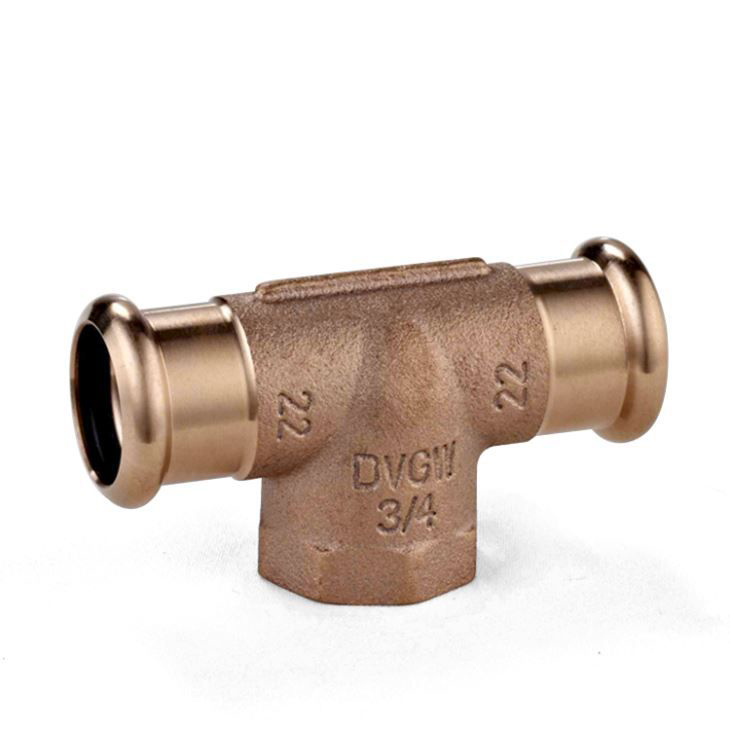The press-fit bronze tee is a vital component in various piping systems, particularly in plumbing, HVAC, and industrial applications. It is designed to connect three pipes at a 90-degree angle, allowing for fluid or gas flow in different directions. The quality and durability of a press-fit bronze tee depend largely on the materials selected during its manufacturing. With proper material choice, the fitting can offer performance, longevity, and resistance to corrosion.

Bronze is an alloy of copper, typically mixed with tin and sometimes small amounts of other elements such as phosphorus, manganese, or aluminum. It has been used for centuries due to its desirable physical properties, particularly in industrial and plumbing applications. When selecting the appropriate material for a press-fit bronze tee, understanding the specific qualities of bronze is crucial.
1. Corrosion Resistance
Bronze's resistance to corrosion is one of its significant advantages, especially in applications where the fitting will be exposed to moisture or harsh chemicals. The presence of tin in bronze alloys provides resistance to rust and oxidation, making it an material for piping systems exposed to water or moist environments.
Why It Matters: In plumbing and industrial systems, corrosion can weaken the fitting, leaks, reduced efficiency, and potential system failure. Choosing a bronze alloy with corrosion resistance ensures that the tee will perform reliably over time.
2. Strength and Durability
Bronze alloys are known for their strength and durability, offering good mechanical properties like tensile strength and wear resistance. Depending on the specific composition of the alloy, bronze can provide an balance of strength and ductility, which is crucial for press-fit fittings that must withstand internal pressures and mechanical stresses.
Why It Matters: A strong, durable material ensures that the press-fit bronze tee can withstand the pressures and stresses of fluid systems without deforming or failing. It also contributes to the overall integrity of the piping system.
3. Thermal Conductivity
Bronze has good thermal conductivity, meaning it can efficiently transfer heat. This property is particularly important in applications where temperature fluctuations are expected. A press-fit bronze tee with high thermal conductivity can prevent thermal stress and ensure that the fitting maintains its shape and functionality under varying temperature conditions.
Why It Matters: In systems where the temperature fluctuates, maintaining the integrity of the material under heat and cold is critical. A material with good thermal conductivity will ensure that the fitting performs well in diverse environmental conditions.
4. Malleability and Workability
Bronze is also relatively easy to work with. Its malleability allows it to be formed into various shapes and sizes, which is essential in the manufacturing of press-fit fittings. The ability to press-fit pipes into the tee without additional heating or welding makes the material both convenient and cost-effective.
Why It Matters: The ease of working with bronze makes it a practical choice for mass production and ensures that press-fit fittings can be manufactured quickly and with high precision.
Alloy Grades of Bronze for Press-Fit Tees
Different grades of bronze offer varied properties, which can influence the selection process for press-fit bronze tees. The common bronze alloys used in plumbing and industrial fittings include:
1. Phosphor Bronze (C51000)
Phosphor bronze is known for its corrosion resistance, particularly in environments with exposure to water and chemicals. It also offers good wear resistance and strength. Phosphor bronze is often used in marine applications and areas prone to high humidity.
Advantages:
Good corrosion resistance, especially in water systems
High strength and fatigue resistance
Good electrical conductivity
Ideal For: Plumbing systems, marine environments, and industrial applications exposed to moisture or chemicals.
 +86-576-82686004
+86-576-82686004
 allen@badavalve.com / daisy@badavalve.com
allen@badavalve.com / daisy@badavalve.com





 EN
EN
 Español
Español










